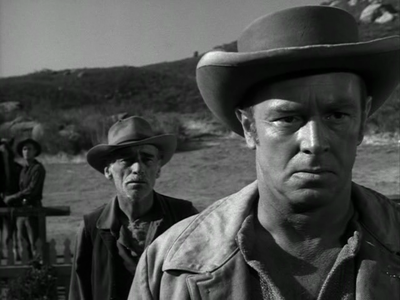« Coffee Break | Main | Clip »
June 04, 2013
Valerie

Gerd Oswald - 1957
MGM Limited Edition DVD
I first became aware of Valerie from the notes on Gerd Oswald in The American Cinema. Andrew Sarris described the film as a "frontier Roshomon". The main differences that such a description does not address is that while the film takes place in and near a fictional town called Limerock not too long after the Civil War, in spite of the film's setting, the film can not truly be considered a western. And unlike Akira Kurosawa's film which centered on one incident seen from the point of view of several people, Oswald's film recounts a series of incidents from the point of view of three people. Setting aside the era in which the film takes place, and the physical setting, Valerie does fit in visually and thematically with Oswald's other film noir work, and is not too removed from his later assignments on the "Perry Mason" television series.
What impresses me most about Valerie is how much information Oswald is able to contain in a single shot, whether it's to convey the relationship between people or even to establish the location of a scene. The mystery of Valerie is first established with a group shot of three men. Two enter a small house. We hear, but do not see, shooting. Only one man emerges from the house. The remainder of the film takes place during the trial of that man, John Garth. The main witnesses are Garth, the town's preacher, Reverend Blake, and Garth's wife, Valerie. Each describe the events that preceded the shooting. Each also gives somewhat different descriptions not only of the events, but of each other. The film might also be read lightly as political allegory as Garth is the home town hero, while Blake and Valerie are both outsiders, both from outside the United States, with Valerie and her parents cited as "foreigners" from an unnamed country.

Oswald will shoot two different versions of the same incident in the same way. During the night of Garth's honeymoon with Valerie, the camera is facing the towards Valerie's bedroom. In one flashback, we see Garth helplessly standing outside the bedroom, locked out by his bride. In a similarly filmed flashback of that same night, we see Garth swooping up Valerie against her will, carrying her to the bedroom. In one flashback, Garth holds a gun to Blake, while another version shows no threat of violence by Garth. In other scenes, the dialogue is repeated but in a somewhat different situation than what was seen previously.
How Oswald was chosen to direct Valerie, I do not know. His economical, and visually loaded use of a single shot is also examined by C. Jerry Kutner discussing Screaming Mimi, another film based on personal perceptions and interpretations of past events. What is clear is that even as an assignment, Valerie is not dissimilar to Oswald's other credits beginning with A Kiss Before Dying through Screaming Mimi, with narratives about murder, manipulation of the truth, and the difference between facts and perceptions.
The screenplay is by Leonard Heideman and Emmett Murphy. Certain aspects of Heideman's life read like the plots of Oswald's Fifties movies. Additionally, Heideman's life gives Valerie autobiographical weight regarding the relationship between Garth and Valerie, as if parts of the writer's personal life were played out on the big screen. There is some irony to consider that the part of Garth, who might be considered a proxy for Heideman, was played by the physically imposing Sterling Hayden, while Heideman saw himself in his nightmares as a dwarf. What is certain is that Valerie, along with Gerd Oswald's other films from the Fifties, is worthy of much deeper consideration.

Posted by Peter Nellhaus at June 4, 2013 08:46 AM
Comments
There's another significant difference between this film and RASHOMON. In RASHOMON,the different stories are equally unreliable. In VALERIE, we have the Reverend's story which is true but from a restricted viewpoint, Hayden's story which is a lie, and Ekberg's story which tells the full truth. Nice to see Ekberg play, in effect, 3 different roles - the way the Reverend sees her, the way her husband sees her, and the way she sees herself. Have a cigar!
Posted by: C. Jerry Kutner at June 4, 2013 01:51 PM
Thanks for the cigar, Jerry.
Posted by: Peter Nellhaus at June 5, 2013 11:11 AM
